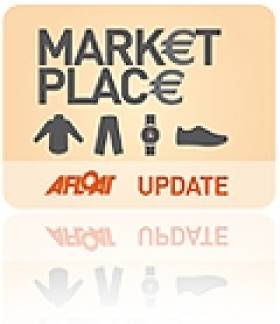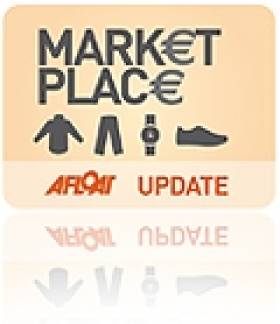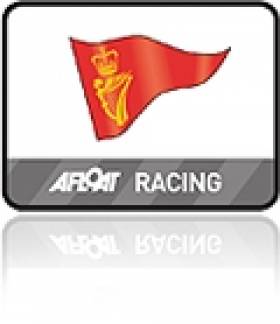Displaying items by tag: CH Marine
New Meaco’s Dehumidifier From CH Marine
Boat owners prefer this type of dehumidifier to compressor dehumidifiers because they work so much better at low temperatures as they do not care whether the temperature is 10°C or 20°C, their performance remains the same. Whereas a compressor dehumidifier if always less effective as the temperature drops, until it eventually freezes up and ice forms on it's coils.
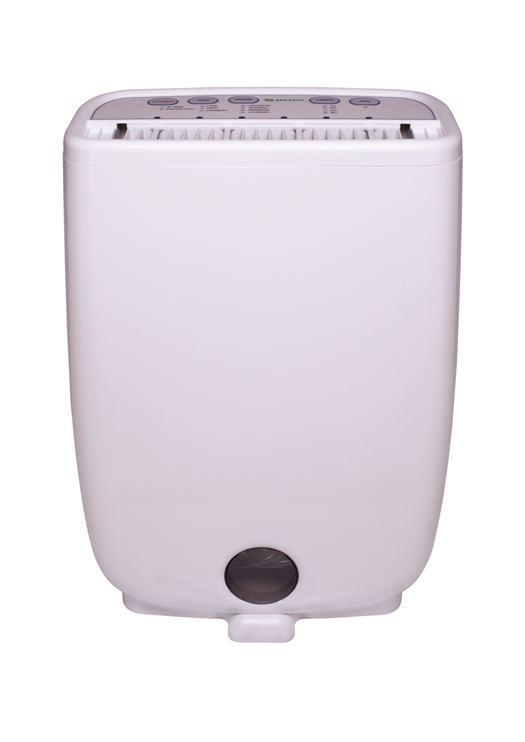
The DD8L and the DD8L Junior look identical and have the same capacity and performance. The difference is that the DD8L has an air treatment facility with a silver-nano filter to kill bacteria and an ioniser to trap dust/pollen etc in the air. So if someone is living on the boat the DD8L is the better dehumidifier, if no-one is on the boat the DD8L Junior is the cheaper and more sensible choice.
What makes these two dehumidifiers special is that desiccant dehumidifiers, when the relative humidity is reached keep the fan running to sample the air for exceptionally accurate dehumidification. On a boat, because the air volume is small, this is not really necessary and having the fan constantly running pushes up the electricity bill, often at rates higher than the normal domestic average tariff.
Meaco have, therefore, made these two new dehumidifiers more intelligent. When the relative humidity is reached the dehumidifier will sample the air for 5 more minutes and will then turn itself off completely. Rather than just stay asleep and maybe miss the relative humidity increasing and being absorbed by organic material, the DD8L and DD8L Junior turn their fan on every 30 minutes for 5 minutes to sample the air. If the relative humidity is still low they go back to sleep, if the relative humidity has increased they start dehumidifying again.
This provides the perfect compromise between accurate dehumidification and energy saving.
If a boat is well sealed and there is no human activity then there is no reason why the relative humidity should increase too fast. Therefore the dehumidifier will only be on for 10 minutes in every sixty, rather than the old method of being on for a continuous 60 minutes. Therefore potentially these new models will use 1/6th of the electricity of the old models.
Both models feature the standard Meaco features for boat dehumidifiers, i.e., no castors so that they do not roll around, lightweight, a hose in the box for continuous drainage, auto restart after a power cut and a laundry drying mode, and whisper quiet mode for those living on board.
The Meaco DD8L is €199.00 and the Meaco DD8L Junior is €169 both including delivery and VAT. These new models will land in the Ireland at the end of October.
For more information on Meaco Products in Ireland, please contact CH Marine Ltd Tel 028 23190 E-mail [email protected]
Fed up Flunking Starts? A New Distance to Start Line Computer is the Answer
Want to improve your starting? Fed up looking for transits only never being able to see the end of the line? Here's a new innovation for racing sailors that Cork sailmaker Des McWilliam has already declared 'a brilliant piece of kit'.
Irish distributors CH Marine are offering a 7 day free trial they're that sure you'll never be late or over the line again. There's a special Irish launch price of €449 for this start computer. Click for online demo and listen to inventor Alec Stewart talking about the 'perfect bowman' below.
Kinsale Heads for 100-mile Fastnet Race
Kinsale Yacht Club's SCORA League Fastnet Race sponsored by CH Marine takes place this Friday at 8pm.
This 100–mile round trip to one of the most iconic ocean racing turning points presents all the challenges to competitors associated with classic offshore/coastal racing.
The many headlands along the track present major tactical decision points for skippers and navigators in their race to make the many tidal gates along the route. This coupled to the often fickle winds make the creation of a race winning strategy extremely difficult.
This now classic race on the South Coast typically attracts competitors from the host Club Kinsale Yacht Club along with competitors from the Royal Cork and Cobh Sailing Club.
The inclusion of the Kinsale Fastnet in SCORA Jim Donegan Memorial Series enhances the standing of this race along the South coast and the very generous sponsorship of this race by CH Marine makes the race highly attractive for South coast sailors.
Intending competitors are reminded that this is a ISAF OSR Cat 3 race with life rafts. Safety checks may be conducted prior to the start.
CH Marine Launches New Chandlery Outlets Nationwide
June sees the official launch of a new concept in the marketing of marine equipment in Ireland.
Recognising that certain areas of Ireland are simply not able to support fully fledged marine stores on a year round basis, CH Marine has come up with the 'CH Marine Instore' concept.
This is a network of new micro- chandleries placed within existing businesses offering a range of the day to day requirements for boaters and sailors alike.
Typically, CH Marine Instore outlets are based in businesses such as Supermarkets, Service Stations, Hardware Stores and Boatyards located close to Ports or Marinas and where customers can stroll up for those simple supplies that are always needed on a boat. Life jackets and spares, marine cleaners and polishes, pumps and floats switches, rope and fenders are just some examples of the typical range of items that will be stocked.
CH Marine already supply a vast range of brand name marine products throughout Ireland, either through their own stores or through their network of Star dealers. The Instore program is seen as an extension of this network, improving service and providing an efficient supply to all areas of Ireland.
So far CH Marine has a network of 16 'Instores', eight of which are on the inland waterways. Full store listing here.
When Afloat.ie spoke to CH Marine's Managing Director, Nicholas Bendon, he explained that the recession had made it difficult to maintain a local supply in certain areas of Ireland and that INSTORE is solution to that problem. "The great thing about INSTORES is that they are true convenience stores and some, such as those in Supermarkets, are open 7 days a week.
They have all agreed to a ' price promise', ensuring that the prices charged will always be the same as CH Marine and there is a back up support of next day delivery on the vast range of CH Marine standard stock items "
Having piloted the scheme last year, CH Marine currently have 16 signed up Instore outlets but the list is expanding and a total of 50 is envisaged.
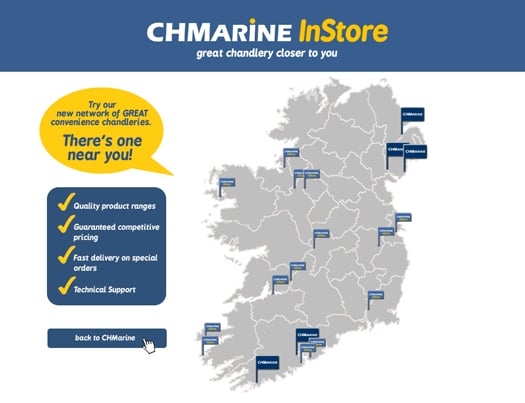
For more info on your nearest CH Marine Instore outlet - click www.chmarine.com/instore
Marine Pocket Guide to Onboard Comfort Covers Every Product
Comprising 64 waterproof, laminated pages, the pocket guide begins with advice on the model of Webasto BlueHeat air or water heater that's right for sailing yachts up to 17m long and motor yachts up to 25m, comparative benefits of both air and water heating systems, plus details of each heater, accessories and diagnosis codes.
BlueHeat hot water stations and Isotemp hot water boilers are also described, along with accessories and trouble-shooting information.
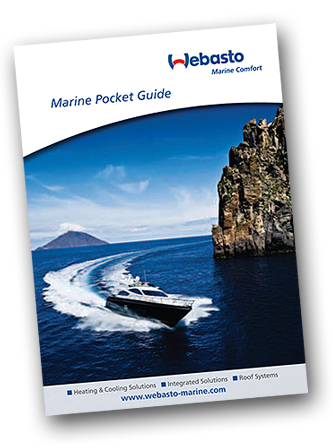
The guide then moves on to the BlueCool portfolio of air conditioners, with a cooling capacity calculator, system characteristics, technical specifications and notes on air handlers, pumps, fresh air units, options, accessories and application guidelines.
A section on BlueComfort Integrated Solutions explains the benefits of combining a self-contained air conditioning system and water heater to produce cooling, heating or a combination of both for unrivalled dehumidification power.
The guide signs off with full descriptions of the 60, 80 and 150 Series of standard and fully bespoke powered marine roof systems, a useful units and conversions page and space for personal information.
For further information in Ireland please contact: Tim Baudain Email: [email protected] Web: www.webasto-marine.com or www chmarine.com
29 Compete in CH Marine Winter League
A very good fleet of 29 cruisers came to the line for the first day of the CH Marine Winter league writes Claire Bateman. The first radio sound to be heard was the familiar voice of Afloat correspondent Tom MacSweeney, who was PRO for the occasion, advising the course to be sailed would 99, sailing Classes One and Two together and Classes 3 and White Sail also together. An equally well known voice came back wondering whether there would be water at one particular mark!!
The sea was flat and there was a fitful wintery sun. In spite of the dire forecast that had been promised, one could have been doing a lot worse than enjoying a race in Cork Harbour.
The course turned out to be a good choice as it is divided into three parts and could be shortened after any one of the three rounds. The wind from the ESB stack at Whitegate was showing north west, Met Eireann report from Roches Point was giving 5 knots from the west and the Race Officer for the Laser fleet was setting a course for a south west wind. It was that kind of day.
It was an off wind start and True Penance with Joe English on spinnaker got the best start with End Game just behind with Jimmy Nyhan trimming the spinnaker, and Bad Company was looking good as well on the shore side. Magnet was throwing all sorts of shapes at the cage but a was bit slow hoisting her spinnaker.
Classes Three and White Sail sailed one round of the course and Classes One and Two got in two rounds. This worked out very well because as the race progressed the tide was getting stronger and this helped the boats to make it out the harbour against the tide so it all jelled very well.
The prize giving followed at which CH Marine presented the competitors with very seasonal and acceptable bottles of wine and boxes of Cadburys Roses and immediately afterwards the threatened rain began to pour down but as this stage the competitors were not bothered as they were ready to go home having enjoyed a great day of racing.
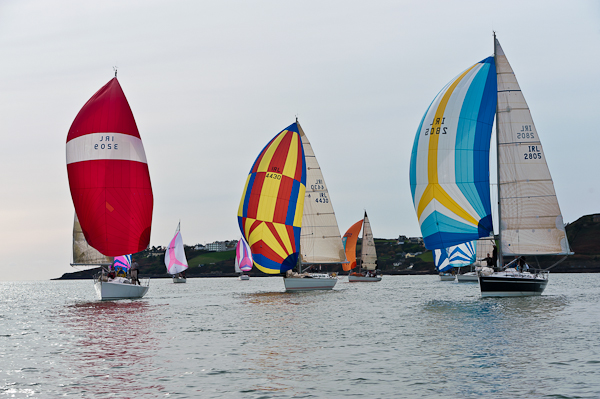
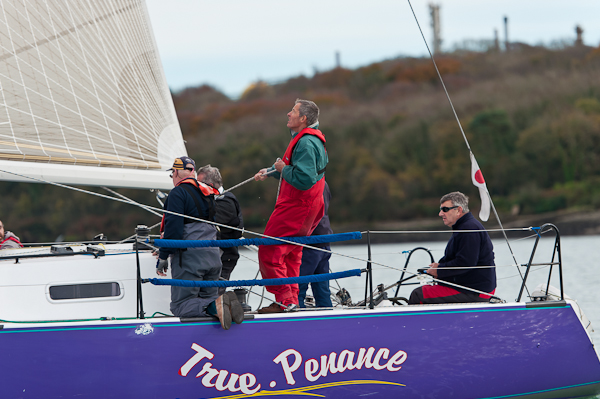


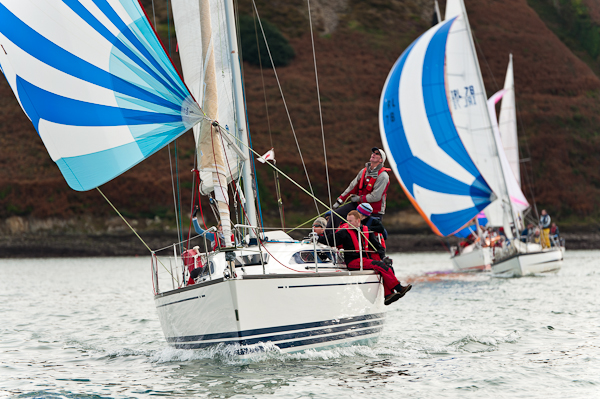
Photos by Bob Bateman





























